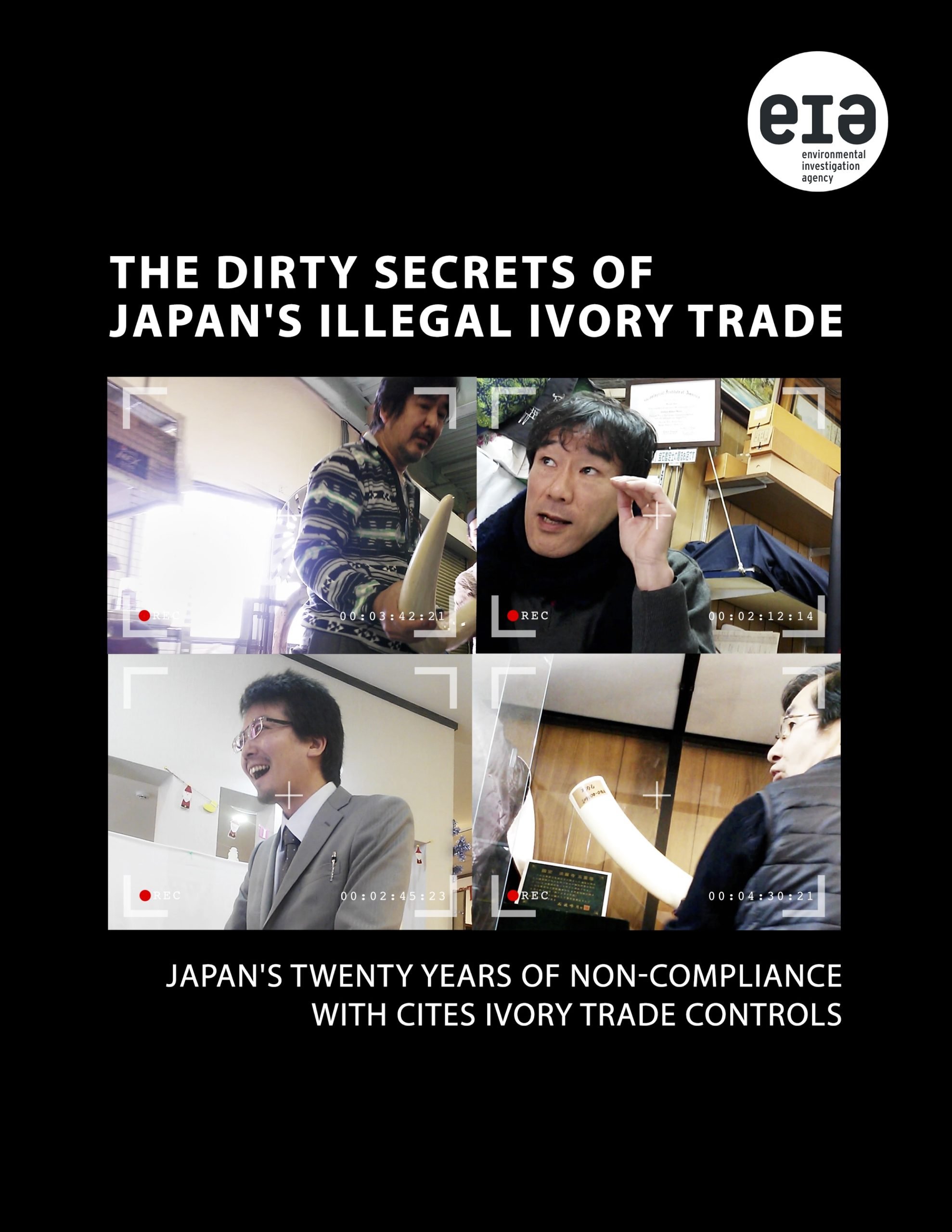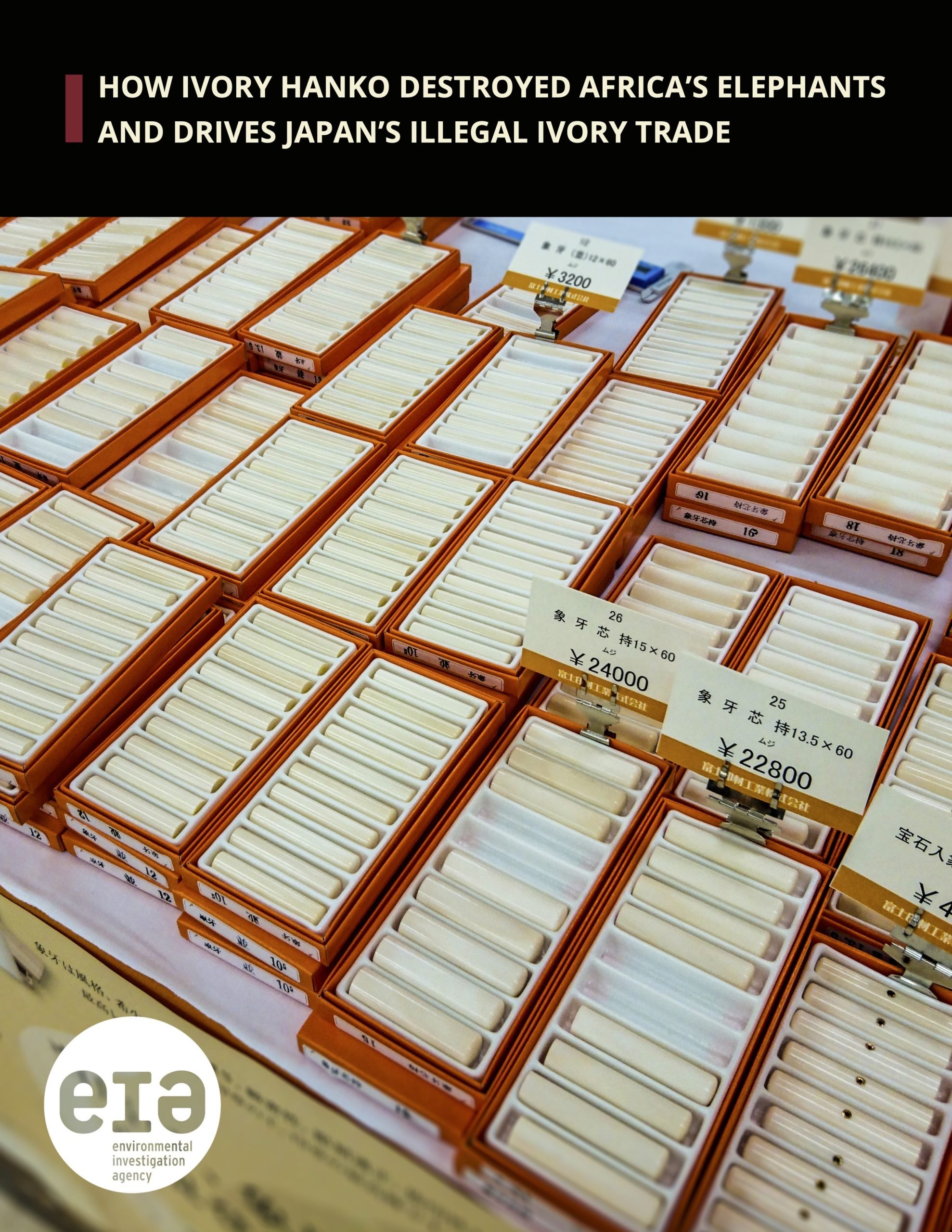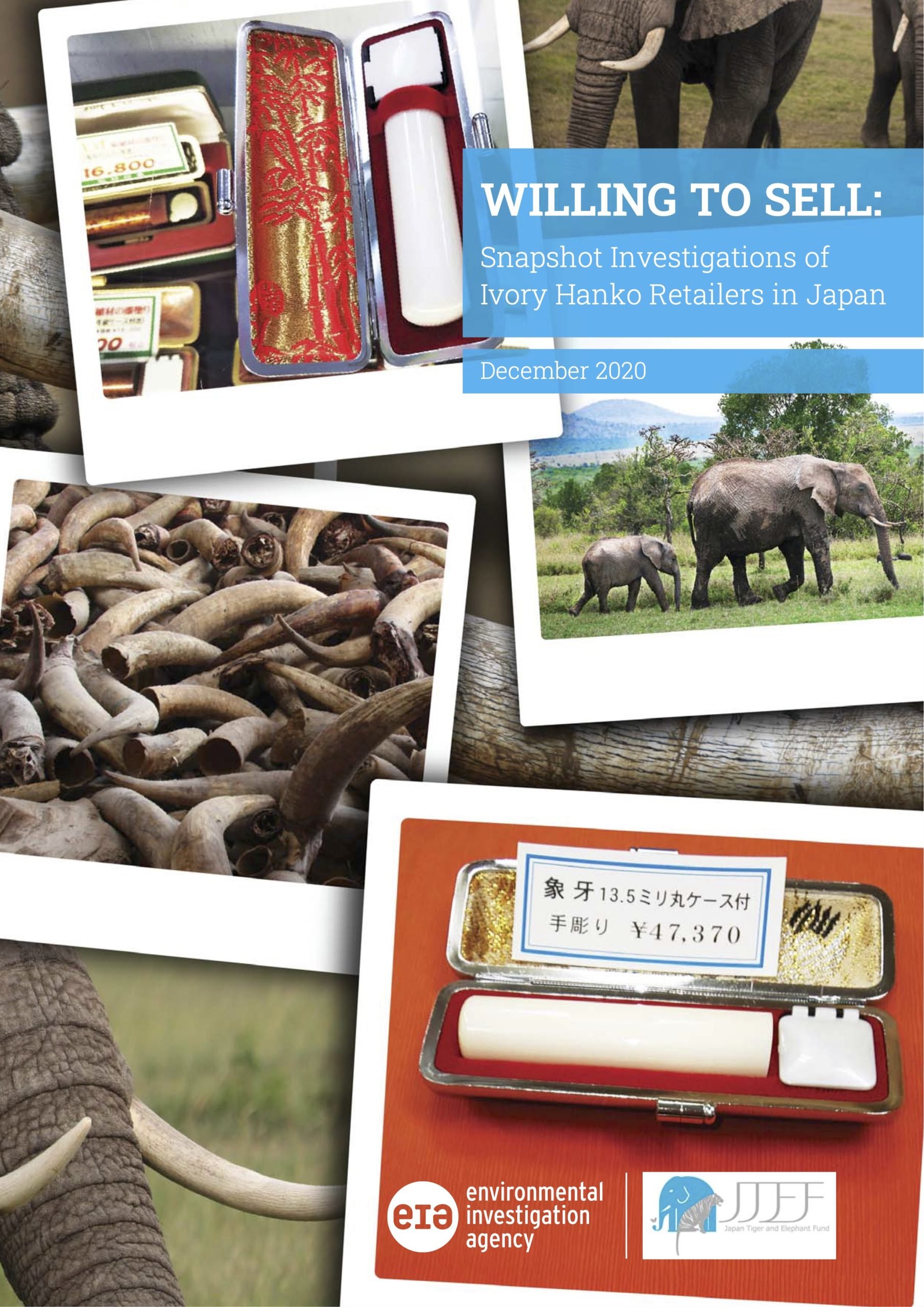Elephant Ivory vs. Japan:
A Timeline
-
1973
International agreement CITES established
-
1975
CITES - Asian elephants listed to Appendix I - International ban on trade
-
1976
CITES - African elephants listed to Appendix III
-
1977
CITES - African elephants moved to Appendix II
-
1979
African elephants number 1.3 million
-
1980
Japan becomes a Party to CITES; CITES enters into force in Japan
-
1970-1989
Japan imports ivory equivalent to more than 250,000 elephants, mostly poached
-
1989
African elephant population is cut down to 610,000
-

CITES Appendix I listing for African elephants – International ban on commercial trade in ivory secured
-
1992
Japan enacts Law on Conservation of Endangered Species of Wild Fauna and Flora (LCES)
-
1995
Japan’s whole tusk registration system initiates; whole elephant tusks are registered for sale without real proof of legal origin or acquisition.
-
1990s
Poaching slows, and elephant populations begin to recover across Africa
-
1997
CITES authorizes a conditional sale of ivory stockpiles to Japan
Elephant populations in Zimbabwe, Namibia, and Botswana moved to Appendix II
The Elephant Trade Information System (ETIS) mandated by CITES
-

1999
CITES-approved sale of 50 tonnes (5,446 tusks) of ivory to Japan occurs
-
2000
South Africa’s elephant population transferred from Appendix I to II
-

2002
Seizure of 6.2 tonnes of ivory in Singapore, destined for Japan. EIA UK’s report Back in Business – Elephant poaching and the ivory black markets in Asia revealed existence of an organized syndicate, the trade route from Zambia to Singapore and Guangzhou via Malawi and Singapore, final destination was Japan.
-
2004
China considered the largest ivory market in the world - CITES CoP12 analysis reports China surpassed Japan’s scale of ivory manufacturing
-
2006
Seizure made in Japan of 2.8 tonnes of raw ivory and ivory hanko
-
2007
Japan is granted Approved (ivory) Buyer status by CITES SC
CITES authorizes a conditional sale of ivory stockpiles, pending Secretariat approval and buyer status.
-

EIA’s report Made in China: How China’s illegal ivory trade is causing a 21st century African elephant disaster outlines how China’s demand for ivory is fueling a new poaching crisis and recommends that CITES SC does not approve China’s request for approved buyer status.
-
1999-2008
Elephant poaching increases across Africa
-

2008
China is granted Approved Buyer status by CITES SC
Second CITES-approved sale of ivory of 102 tonnes occurs – from Zimbabwe, Namibia, Botswana, and South Africa to Japan and China
Legal sale of ivory triggers increases consumer demand and black market activity
-

2009
CITES-approved sale of 39 tonnes (3,365 tusks) of ivory imported to Japan
-
2010
IUCN recognizes African forest elephants (Loxodonta cyclotis) and African savanna elephants (Loxodonta africana) as genetically distinct, separate species
-
2010-2012
An estimated 100,000 elephants were killed to fuel the demand for their ivory (average of 33,000 annually).
2011 is considered the worst year on record for elephant poaching, with some 40,000 elephants killed
-
2012
Evidence shared in EIA UK’s report Blood Ivory: Exposing the myth of a regulated market highlights the lack of control in China’s domestic market and increased demand for illegal ivory in China.
-
2002-2013
Central Africa’s forest elephant populations decline by 63 percent
-
2013
A report Elephant in the Dust– The African Elephant Crisis by UNEP, CITES Secretariat, IUCN and TRAFFIC was released at CITES CoP13, and the CITES community was forced to realize the serious poaching crisis of elephants
JTEF’s report What Lies Beneath: Exposing the loopholes within Japan’s control of internal ivory trade draws international attention to the flaws in Japan’s LCES
-
2007-2014
Comprehensive aerial survey of African range states confirms that 30 percent of Africa’s savanna elephants in 14 nations and one transfrontier area surveyed were lost.
-

2014
EIA’s report Blood e-Commerce: Rakuten’s profits from the slaughter of elephants and whales found 28,000 advertisement for ivory products, 90 percent of which were hanko, on Rakuten Ichiba, the largest e-commerce platform in Japan
-

2015
EIA’s report Japan’s Illegal Ivory Trade and Fraudulent Registration of Ivory Tusks reveals evidence that Japan’s whole tusk registration system is full of loopholes that enable the laundering of illegal tusks.
November 6th: Twenty-five African countries issue the Cotonou Declaration, demanding a ban on ivory trade worldwide, including domestic trade.
Leading Japanese retailer AEON prohibits ivory sales in its directly manages stores
-

2016
Revisions to CITES Resolution Conf. 10.10 (Rev. CoP17) include a recommendation to Parties and non-Parties to close domestic ivory markets that are contributing to poaching or illegal trade
African elephant population estimated to be 415,000
USA enacts a near-total ban on the commercial domestic ivory trade
China and Hong Kong SAR announce ivory market closure schedules (2018 and 2021, respectively)
-

Evidence revealed in EIA’s report, The Dirty Secrets of Japan’s Illegal Ivory Trade, demonstrates the willingness of Japanese ivory traders to participate in illegal trade and exports despite knowing illegalities, and that auction sites facilitated by the world’s largest online ivory seller, Yahoo! Japan, generated revenues of over US$25 million (¥2.3 billion) occurring a seven-year period from 2008 to 2014
-
1995-2017
Between 1995 and mid-2017, the Government of Japan registers some 20,000 ivory tusks for sale without requiring proof of legal origin
-
2017
In August, Japan launches two-year whole tusk registration campaign - essentially an amnesty - to encourage the registration of tusks in private possession before new restrictions in 2019
Japan’s e-commerce leader Rakuten Ichiba bans elephant ivory sales
Japan’s Mercari Inc. bans the sale of elephant ivory products
AEON announces phase-out of all elephant ivory sales by tenants in its numerous malls across Japan
WWF and TRAFFIC call on the Government of Japan to close its domestic market
-
2018
With the closure of China’s ivory market in January, Japan becomes the world’s largest domestic ivory market.
In July, superficial amendments to Japan’s Law for the Conservation of Endangered Species of Wild Fauna and Flora (LCES) in effect
Major Japanese retailer Ito-Yokado bans mall tenants from selling ivory items
-

Surveys of ivory hanko (name seal) sellers highlight that the hanko industry is susceptible to abuse and fraud in trade and export and further that the GoJ awareness campaign to educate ivory retailers on the legal framework has been unsuccessful. See EIA’s report: How Ivory Hanko Destroyed Africa’s Elephants and Drives Japan’s Illegal Ivory Trade
-
2017-2019
4,400 whole tusks registered during Japan’s registration campaign
-
2019
In July, GoJ implements a carbon dating requirement for registering whole tusks, but the measure is ineffective
EIA’s briefing, Persistent Problem: Japan’s Domestic Ivory Trade, and infographic prepared for CoP18, draws attention to an alarming lack of regulatory controls for Japan, the world’s largest legal domestic ivory market.
CITES Resolution Conf. 10.10 (Rev.CoP18) further reinforcing measures to combat ivory trafficking and trade: Parties that have not closed their ivory markets requested to report on measures they are taking to ensure that their domestic ivory markets are not contributing to poaching or illegal trade.
Yahoo! Japan ends sales of all ivory products on its platforms
-

EIA’s briefing, Persistent Problem: Japan’s Domestic Ivory Trade, and infographic prepared for CoP18, draws attention to an alarming lack of regulatory controls for Japan, the world’s largest legal domestic ivory market.
-
2018-2020
EIA documents 76 seizures of ivory from Japan made in other jurisdictions, including 72 made in China.
-
2020
Tokyo Metropolitan Government (TMG) established the Advisory Council on Regulation of Ivory Trade to assess the ivory trade within Tokyo, analyze existing regulations on domestic ivory trade, and assess and propose measures on ivory to be taken by the TMG.
Taiwan closed its domestic ivory market
WWF/Globescan study finds that 12% of Chinese travelers to Japan purchased ivory, with the majority illegally exporting those ivory products to China.
-

EIA’s report Willing to Sell: Snapshot Investigations of Ivory Hanko Retailers in Japan, reveals investigation results that many Japanese hanko retailers are willing to sell an ivory product knowing that it will be exported internationally despite most being aware that ivory export is illegal.
-
2021
IUCN updates the listing of African elephants on its Red List of Threatened Species. Previously listed collectively as “Vulnerable,” now African savanna elephants are listed as “Endangered” and African forest elephants are listed as “Critically Endangered.”
Hong Kong SAR closes elephant ivory market
Tokyo Metropolitan Government announced short term measures on ivory; falls short of closing the market before hosting the postponed Olympic Games
UK closes its ivory market with the UK Ivory Act
Singapore closes its domestic elephant ivory market
-
2022
EU implements an ivory trade ban with narrow exceptions
An analysis of Chinese court cases regarding illegal ivory imports from Japan found a significant level of organized crime and the involvement of government-registered traders who had been convicted of past ivory trade-related crimes still active today. See JTEF’s report: Smugglers’ Source: Japan’s Legal Ivory Market – An Analysis of Chinese Court Decisions of Ivory Illegally Exported from Japan.
CITES CoP19 agreed to a proposal submitted by elephant range states includes a proposal to conduct an analysis of ivory trafficking incidents linked to countries with legal domestic ivory markets in order to help CITES Parties make informed decisions about market closures.
-

2023
In Reality Check, EIA and JTEF make the case for Japan’s open domestic ivory market to be included in the analysis of seizures related to open markets.